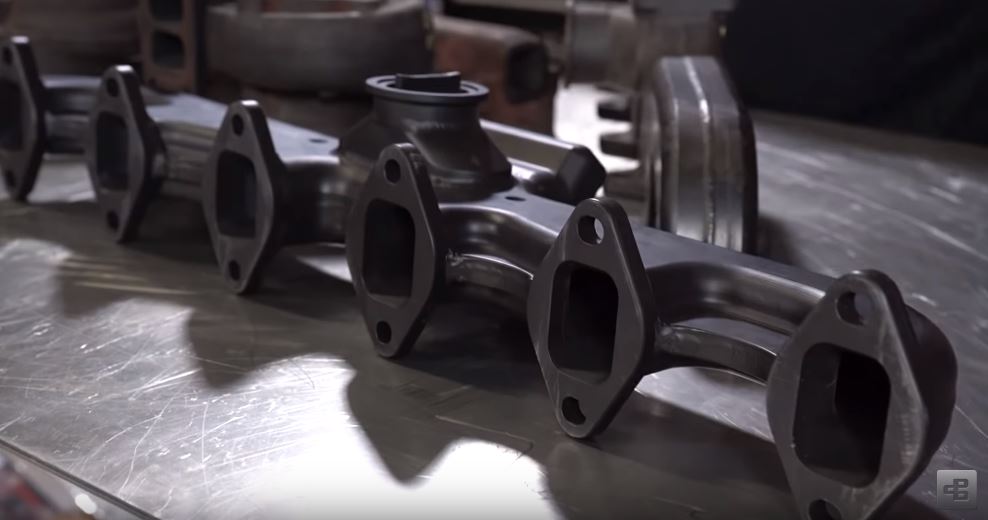TURBOS
Diesel Exhaust Manifolds Explained
In this post, we’re explaining exhaust manifolds – what’s the difference between them, when to and why to upgrade, and more. Read on for all the Cummins exhaust manifold information you could ever want.
Why Upgrade an Exhaust Manifold?
So, why should you upgrade your exhaust manifold? One reason would be to to move away from a solid manifold to a three piece manifold. The stock manifold is normally a 1 piece cast iron piece that will shrink over time and many heat cycles. This is particularly a problem on the Cummins 12 valve as it might actually break off the “ears” of the exhast ports.

The three piece manifold systems are built with three different pieces press-fit together. This allows the individual pieces to move slightly and adjust for the heat expansion and contraction. There are numerous manufacturers that produce great quality three piece manifolds.

However, there are some downsides to the three piece manifolds. You will notice there is the area where the center and side pieces join is quite large. This is for strength and reinforcement. However, it also means that if you have a big, beefy turbo you want to use with your engine, it won’t fit on the three piece manifolds. We have seen people grind these areas down to fit their turbos, and other mods.

You might also want to upgrade your manifold because you want to go with a bigger turbo. For example, moving up to a T4 turbo would require a bigger manifold – we’ve even gone up to a T6 on Todd’s race truck.
What’s Special About Steed Speed Manifolds?
Another options for upgrading your exhaust manifold is a Steed Speed manifold. Unlike other manifolds that are cast, Steed Speed manifolds are milled from two seperate pieces of metal, then welded together. The advantage of Steed Speed manifolds is that they are extremely customizable. Steed Speed can make manifolds that will match your engine layout, turbo choice, and much more. Todd recently had a Steed Speed manifold built for a T3 turbo with an open volute. This allowed us to test out an exhaust diverter valve, which required this setup.
Something else nice about Steed manifolds are that you can have an external wastegate port included. When going to nitrous or big turbos, an external wastegate is going to outperform an
internal one, especially on a high-powered competition truck.


What’s the Difference Between Dual Volute and Open Volute Manifolds?
When looking at a manifold, the first thing you will notice is if it has an open or dual volute (seen in the turbine housing image below). In a dual volute turbine, or twin scroll, housing, the housing is divided all the way through to the exhaust wheel. The idea is that every time a cylinder releases exhaust, it is only diffused in half the turbine housing, as opposed to the entire opening with an open volute housing.

Because the exhaust is only hitting half the housing, it aids in the turbo spooling up faster and reduces spool lag. The downside to the dual volute housing is that eventually the divider cracks. The more miles and higher power on the turbo, the more likely it is that cracks will occur. An open volute turbo will not generally have this issue.
Second Gen Swap on Common Rail Engines
On common rail trucks, a lot of people want to get the double volute manifold in place of the open volute manifold that is stock on some common rail trucks. This allows for upgraded turbos and faster spool up. This creates a whole host of additional upgrades that need to happen.
With this upgrade, now your exhaust outlet is in a different spot which will make a new downpipe necassary. With the turbo in a different location you will need new intercooler tubes, and probably new oil feed and drain lines as well as a new air intake. So, keep these things in mind if you are considering this manifold swap.
Third Gen Exhaust Manifolds
On a common rail exhaust manifold, the heat expansion is much less of an issue because there are no ears to crack on the head. It is a smooth piece of solid cast iron. This means that as manifold expands and contracts the likelihood of damaging your head is small.

These common rail manifolds come in divided and open ports. This means you can get the benefits of a second gen swap without all of the work and effort of actually putting in a second gen manifold. The real benefit of the second gen swap is the pulsing exhaust that speeds up turbo spool.
Match the Manifold to Your Truck
At the end of the day, we feel that upgrading your exhaust manifold is a supporting mod and that you should match the manifold to what you want your truck to do. You may or may not need an expensive manifold, depending on the power needs and goals for your truck.
If you have questions about the manifold on your truck, give us a call at the shop and we can help you figure out what you need. We’re happy to answer any questions and give our recommendations. Contact us at 435-962-9555 or text us at 435-962-9506, or hit us up on Facebook, Instagram, or leave a comment below. We try to answer any and all questions as quickly as possible.


Is it recommended or not to use an adapter to adapt a s366 turbo to a stock 6.7 cummins manifold on a 2011 ram
I would highly recommend against using an adapter and would suggest ordering a whole manifold instead. Adapters are prone to leaking and the extra space it requires may cause the turbo to contact the frame from lack of clearance.